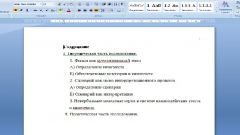Instruction
1
Before creating the practical part is necessary first of all to obtain scientific information that will form the basis of this Chapter of the diploma or course work. For research you need to use all possible methods: analysis and synthesis, experiment, survey, observation. What matters is that you formulated a hypothesis, which will need to prove or disprove.
2
Once you have stocked up the necessary information, the next step is its validation. You will need to determine whether the received information is new, whether it is accurate, objective, and complete and convincingly. Importantly at this stage to ensure that the information does comply with those criteria, not wishful thinking. If it is so, you can move on to the next stage.
3
You need to evaluate the amount of information collected and make a decision on the need for further collection. If you are sure that the accumulated material is enough, then you can go to the wording of the conclusions of your research. If you feel that information is insufficient or it does not meet the criteria of accuracy, completeness, and novelty, should continue to study the problem.
4
Next, you need to make a number of conclusions on the topic of diploma or coursework. First and foremost is the General conclusion concerning the essence of the problem: it was possible or not to you to solve it. Then you should write a conclusions side questions that arose during study of the topic and that led you to the final conclusion.
5
Next you need to indicate how useful your research, and what practical application they have. The more such insights, the more useful your work the better is the result. Also, don't forget to write perspective on your research, is it possible to develop it further, and what an opportunity this gives. Finally, once you have received the necessary conclusions, check whether they match the initial hypothesis.






